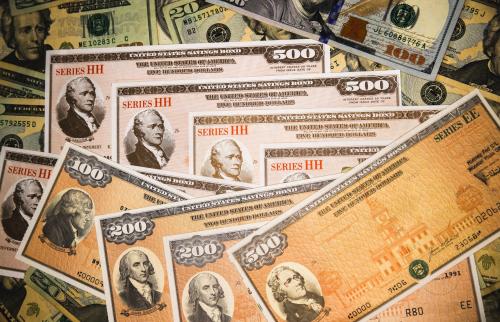Nellie Liang is a senior fellow in the Hutchins Center on Fiscal and Monetary Policy in the Economic Studies program at Brookings. From July 2021 to January 2025, she served as Under Secretary of the Treasury for domestic finance, the office that oversees Treasury debt issuance. This post is drawn, in part, from her April 8, 2025, testimony at a House Financial Services Committee hearing, which you can read in full here.
Why is the market for US Treasury debt so important?
There is no larger thoroughfare for global capital than the market for U.S. Treasury debt securities. It averages around $900 billion in transactions per day, with high volume days in recent years around $1.5 trillion. In addition, there is roughly $4 trillion in Treasury repurchase agreement—or repo—financing each day. And average daily trading volume in U.S. Treasury futures was $645 billion in notional in 2023 and higher in 2024.
The Treasury market serves several critical functions. It is key for financing the U.S. government at the lowest cost to the taxpayer. It is an important channel for the Federal Reserve’s monetary policy. It provides the benchmark risk-free yield curve for pricing risky assets. And it serves as a key source of safe and liquid assets for investors and is used for liquidity risk management by many financial firms, both banks and nonbanks. To serve these critical functions, the Treasury market needs to be deep and liquid. Market participants need to be able to sell Treasury securities without materially impacting the price and at low transaction costs, not only under normal economic conditions but also during periods of uncertainty and stress.
What fragilities in the Treasury market are concerning?
The Treasury market has changed significantly in the past couple of decades in ways that make market liquidity less resilient to big shocks. The amount of Treasury market debt has increased enormously because of large federal deficits. At the same time, intermediation has changed significantly. Traditional securities dealers have pulled back from market making after capital standards and risk management practices were strengthened after the Global Financial Crisis (GFC) in 2008. Electronic trading has increased and principal trading firms, typically with smaller capital cushions than securities dealers, now represent most of the trading in electronic, inter-dealer markets. And the investor base is more price sensitive, as private funds with leverage or redemption pressures have increased their holdings of Treasuries, and the share held by foreign official entities who are less price-sensitive has fallen. The share of Treasuries held by money market funds, mutual funds, and hedge funds has risen to more than 27%, while the share held by foreign holders has fallen from about 50% in 2015 to 30% now.
What lessons did we learn from what happened in the Treasury market in March 2020 at the onset of COVID?
When COVID hit, it was far from clear what it would mean for the economy and for day-to-day life. In the Treasury market, market liquidity deteriorated by much more than expected; dealers and other intermediaries’ capacity to buy Treasury debt was overwhelmed by selling of Treasuries by investors who faced funding pressures or others who wanted ultra-safe cash—the “dash for cash.” Open-end bond mutual funds and hedge funds needed cash to meet margin calls or to satisfy investor redemptions. They chose to sell their most liquid securities—Treasuries. This surge in desired selling exceeded the ability or willingness of dealers to supply liquidity in the face of unprecedented risks and disruptions to normal practices, as many traders were sent to work from home. Treasury prices fell and interest rates rose sharply, especially for off-the-run securities (those issued before the most recent issue and which are still outstanding). The sharp rise in rates contrasted sharply with past episodes of high uncertainty when the flight of investors to the safe haven of Treasury securities would drive down interest rates.
Market functioning was restored only after the Federal Reserve began purchasing huge amounts of Treasury securities to provide liquidity. To put this in perspective, the Fed bought $80 million a month on long-term government debt in the third round of Quantitative Easing (QE3) in 2012. In the week of March 25, 2020, the Fed bought $360 billion in Treasuries. The Fed ultimately committed to “purchase Treasury securities and agency mortgage-backed securities purchases in the amounts needed to support smooth market functioning and the effective transmission of monetary policy to broader financial conditions.”
Fortunately, the Fed’s purchases to restore market functioning in March 2020 were aligned with its monetary policy objectives at the time—to stimulate the economy and raise inflation to its 2% target. It is possible, however, that the Fed may someday confront the need to purchase Treasury securities at a time when doing so would conflict with achieving its mandate of maximum employment and price stability. Avoiding this conflict underscores the importance of regulatory reforms to strengthen Treasury market resilience.
What happened in the Treasury market in early April 2025?
The tariffs President Trump announced on April 2 were bigger and broader than expected and created massive uncertainty for the economy. Financial market volatility soared. Treasury yields fell initially amid growing concerns about a recession, but the yield on longer-term Treasury debt began to rise later that week as investors reassessed the prospects for higher inflation and weaker growth over a longer horizon.
With the escalation of tariffs and no clear signs of an off-ramp, financial asset prices became even more volatile. The rise in the 10-year Treasury yield accelerated with unusual speed from less than 4% percent on Friday, April 4, to spike to 4.5% intra-day on Tuesday, April 8, and the 30-year yield topped 5%. Market liquidity declined as intermediaries often pull back from risk-taking and raise transaction costs when volatility is high. The spread of Treasury yields-to-OIS (also known as the interest rate swap) at longer maturities, a measure of the demand for Treasury securities relative to the fixed rate on the interest rate swap, widened sharply late Monday, April 7, raising concerns that market liquidity for Treasury securities was deteriorating further. Amid the turmoil, the Treasury’s auction of 3-year Treasury notes was weaker than usual. Investors began questioning whether markets would become dysfunctional, as they were in March 2020.
But the worst fears about market functioning eased on Wednesday, April 9, when demand was strong at the Treasury’s auction of 10-year bonds and after President Trump announced a 90-day delay in tariffs for some countries, though he increased them with China. The 30-year auction also went well the next day. The Treasury yield curve, however, still remains steeper than before the tariffs were announced, and yields on 10-year and 30-year Treasury securities are up around 25-50 basis points from their recent lows on April 4.
Some investors speculated that the sharp rise in yields of longer-term Treasuries indicated that leveraged hedge funds were facing funding pressures and that resulting sales would force Treasury yields even higher. Indicators from the repo market suggest some funding pressures but not of the magnitude to explain the swap spread, though some believe they could have worsened materially if uncertainty remained high or increased further. Others speculated that some of the rise in rates came from increasing doubts about Treasury securities as the pre-eminent global safe-haven asset, consistent with the decline in the dollar. A re-pricing of Treasury debt for this reason would be very consequential, forcing the U.S. government to pay more to borrow to finance deficits and raising the costs of borrowing for businesses and households. It will take time with detailed data that the financial regulators have to disentangle how much of the rise in longer-term yields was due to fundamental revisions in the outlook for the economy and inflation, to market illiquidity because of deleveraging pressures that may have forced sales of Treasuries to raise cash, or how much could be from sales because investors repriced the safe-haven quality of Treasury securities. But available evidence suggests that the current episode so far is not a repeat of the market dysfunction in March 2020 from a cash-basis unwind by hedge funds and redemptions from bond funds.
What are the most significant steps taken in the past four years to strengthen the resilience of the Treasury markets?
The work of the Inter-Agency Working Group on Treasury Market Surveillance (IAWG)—composed of staff from the Treasury, the Fed, and financial regulatory agencies—to strengthen Treasury market resilience has focused on expanding dealer intermediation capacity, to reduce surges in demand for liquidity (sales of Treasuries) in periods of high stress, to modernize the infrastructure, and to improve transparency and visibility into the market.
There have been some significant accomplishments. To highlight a few, much more data on Treasury securities transactions and on hedge funds are being disclosed to the public. New data are being collected on a key segment of the repo market—the bilateral uncleared repo market, where dealers finance their hedge fund clients. This market represents about one-half of the total repo market but has been opaque to authorities since before the GFC. In addition, Treasury initiated a buyback program to allow dealers to sell off-the-run securities on a predictable basis to help free up their balance sheets. The Fed put in place a standing facility to finance Treasury repo with pre-authorized dealers and banks which could encourage dealers to invest in market-making capacity and support liquidity in times of market stress.
What’s left to be done?
Of special importance is complete implementation of the Securities and Exchange Commission’s rule to mandate more central clearing of Treasury and repo. Central clearing is used for other assets and can reduce risk by standardizing risk management requirements and increase intermediation capacity through multilateral netting. There are many complicated operational, regulatory, and accounting issues to resolve, and industry groups are actively engaged and committed to addressing them. They recently received an extension of the deadlines by one year for central clearing Treasury securities in December 2026 and Treasury repo in June 2027. As I noted in my recent Congressional testimony, I don’t believe they should delay further.
Changes should be considered to the supplementary leverage ratio (SLR) put in place following the GFC. The SLR requires banking firms to hold the same amount of capital for riskless reserves at the central bank as they would for risky assets. One change could be to exclude central bank reserves and perhaps Treasury securities in the trading book (but not all Treasuries because they have interest rate risk) from the SLR calculation, but importantly, with an adjustment so that there would not be a reduction in bank capital. This adjustment would preserve safety and soundness and would let the SLR function as intended as a backstop.
To reduce surges in selling in periods of stress, open-end bond funds should be required to reduce significant liquidity mismatches, which force Treasury sales. In addition, supervisors should prevent excessive leverage of hedge funds in trades, such as the cash-futures basis trade and others, that can force rapid, disorderly unwinds of positions. The new data on bilateral repo transactions and from Form PF filings, as well as from when central clearing is implemented, should provide much greater visibility into leverage in Treasury markets.
These reforms are complementary and interconnected, and, in my view, all should continue to be pursued. Prudent changes to the SLR would not on its own significantly improve intermediation and strengthen resilience in stress periods, especially as the amount of Treasury debt continues to grow. Central clearing as well as incentives from the SRF are needed to increase intermediation capacity, and stronger rules and supervision to reduce liquidity mismatch and leverage of investors also are needed.
The Brookings Institution is committed to quality, independence, and impact.
We are supported by a diverse array of funders. In line with our values and policies, each Brookings publication represents the sole views of its author(s).







Commentary
What’s going on in the US Treasury market, and why does it matter?
April 14, 2025